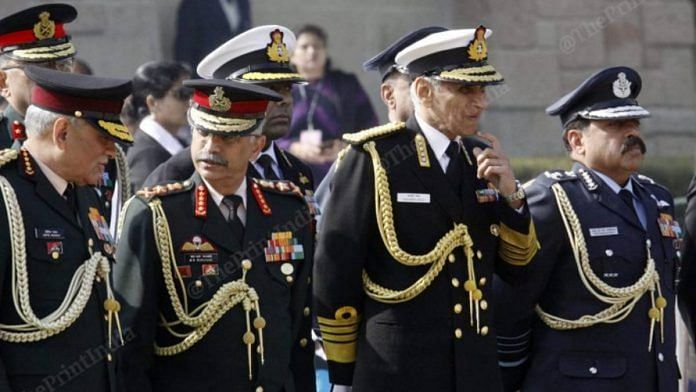New Delhi: With pensions and salaries being the biggest spending factor of the defence budget, the Department of Military Affairs (DMA) is in the process of finalising an increase in retirement age and also commonality among various officer ranks across the three services.
Once these changes are brought in, the concept of re-employment in the armed forces will also come down, sources in the defence and security establishment told ThePrint adding that the shortfall of officers will also reduce.
The sources said that work is also on to tweak the re-employment responsibilities so that re-employed officers can work at the same level as their rank, rather than the current practice wherein while the officer draws the salary of his rank, his responsibilities are of much lower rank.
Sources said that increasing pension and salary bills have been a concern because it meant that while the defence budget itself is big in terms of numbers, the actual money spent on modernisation is less.
India had earlier this year emerged as the world’s third-biggest defence spender, after US and China. India outranked Russia, on which it is heavily dependent for defence equipment.
Sources said that the main issue is at the ‘Colonel’ rank since the three services have different ages for retirement, with the Indian Air Force having two different retirement ages depending on whether one is from the ‘flying branch’ or not.
In the Army, a Colonel-rank officer retires at the age of 54. In the Navy, his counterpart, a Captain, retires at the age of 56. In the IAF, their counterpart is a Group Captain. If a Group Captain is from the ‘flying branch’, he retires at the age of 54, while all Group Captains from ‘ground duty’ branches retire at 57.
Similarly, while a Brigadier in the Army and Commodore in the Navy retire at the age of 56, their counterpart in the IAF (Air Commodore) has a retirement age of 56 and 58 years, respectively, depending on whether he is from the flying branch or not.
A Major-General-rank officer retires in the Army at 58, Rear Admirals in the Navy retire at 58 and the retirement age for Air Vice Marshals is also 58.
Also read: MS Dhoni, Anand Mahindra named in 15-member defence ministry panel to review NCC
Ensuring uniformity in services
“The biggest problem is at the colonel rank within the Army since their retirement age is much earlier. On a yearly basis, a total of about 1,000 officers superannuate or retire. Majority of them are usually from Lt Colonel and Colonel ranks, besides Brigadiers. Many of them also apply for re-employment which is usually given,” a defence source said.
Explaining further, the source said that when a Colonel or a Brigadier is taken on re-employment, the responsibility that he is given is that of at least two ranks below.
“Every year, there is a vacancy of nine Brigadiers in the BSF. When a Brigadier joins the BSF, he is posted as DIG, which is generally considered the equivalent of a Brigadier. He draws the salary of a Brigadier and works as a Brigadier only. In the Army, the Brigadier is given responsibilities that are actually given to a Lt Col-rank officer in staff duties,” the source said.
The idea of the DMA, headed by Gen. Bipin Rawat, is to ensure that even if there is re-employment, the force makes the maximum out of the process by ensuring that officers continue to work at the same level.
Also, making the retirement age common for all three services will ensure that there is uniformity and the shortfall of the officer strength is taken care of.
A DMA note in October last year on the proposed new retirement and pension policy had caused serious heartburn in the military, with indications that the three services are not on board.
However, the major concern then was the proposed changes for pension entitlements of those seeking premature release (PMR).
(Edited by Poulomi Banerjee)
(This report has been updated to correctly reflect the retirement age of non-flying Group Captains as 57)
Also read: Army taps Bengaluru-based firm for specialised sights in use with forces abroad



